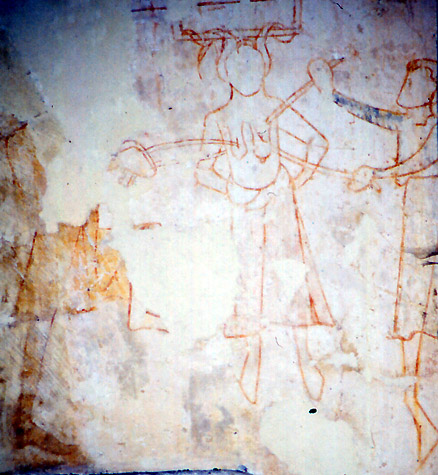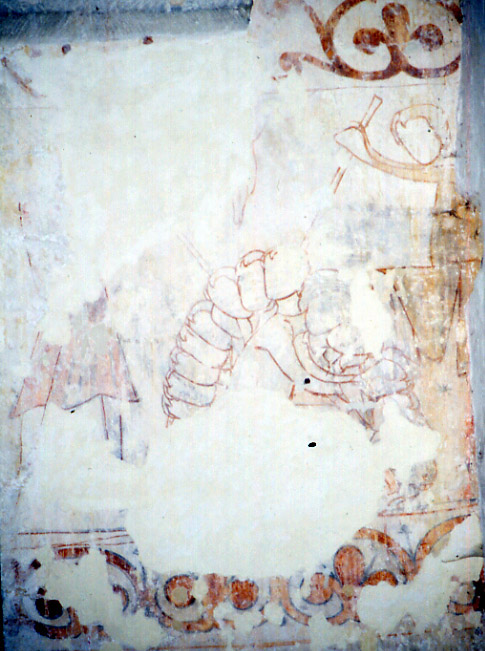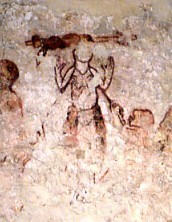Duxford, Cambridgeshire (CCT*) Late C.13
The Martyrdom of St Margaret
“Maiden Margrete
Stood still as any stone
And that loathly worm
To her-ward gan gone
Took her in his foul mouth
And swallowed her flesh and bone
Anon he brast
Damage hath she none!…” ¹

After lengthy consideration I am certain that the female martyr suffering particularly grotesque tortures in the photograph at the left is St Margaret of Antioch and not, as was once thought, St Agatha or another female saint. On the wall immediately below her, and shown at the right below here, is another painting showing a segmented creature which is, I am sure, the remains of the dragon which swallowed the saint, and from whose bursting belly she eventually emerged. She is in fact shown doing precisely that here below in the photograph at the right, and the smaller black-and-white detail, with Margaret outlined, should make this clearer. All that remains of the dragon is the bony debris of its backbone, while below and to the right of it Margaret, leaning forward, comes out, her two rather spade-like hands (identical in shape to the hands of the figure standing above her at the far right) extended before her.
Margaret’s rounded head, face, slender arms and the hands already mentioned are also visible. It is not clear what the figure standing above the emerging Margaret, and his very faint companion at the left are doing, but they may be giving the death-blow to the dragon, since even mythological beasts might lash out when seriously wounded.


What has misled previous commentators (and me too for a long time) is the torture scene painted above it and shown at the top of this page, where the saint hangs suspended by her hair while torturers inflict wounds on her exposed breasts. It is certainly true that St Agatha, whose historical reality is attested to by St Jerome and the martyrologist Venantius Fortunatus among others, did indeed have her breasts sliced off during tortures inflicted on her before her death in prison, and in some early Renaissance paintings she is shown carrying holding them on a dish before her.

But Agatha was not the only female saint to have sex-specific atrocities inflicted on her. The much more dubiously historical (but much more commonly found) St Margaret was tortured in various ingenious ways too, one of which involved her hanging by her hair, as in this painting of her tortures at Little Kimble in Buckinghamshire (a page on these is forthcoming). Margaret’s hair is wound around the crossbar above her exactly as at Duxford, and her torturers are paying particular attention to her naked breasts, of course, humiliation being after all an important component of torture.
St Margaret is similarly suspended by her hair for torture in a very full series of paintings of her Life at Battle Church in Sussex, which I have yet to see, although Clive Rouse includes a photograph as Plate 65 of his Medieval Wall Paintings (Shire Publications, 4th edn.)
As to the dragon, this particularly ‘loathly worm’ is closest in shape and spirit to that in the painting of St Margaret at Charlwood in Surrey.
The Warning to Sabbath Breakers in the church is already on the site, and there are other paintings at Duxford, including a very faint Crucifixion and Resurrection which I will try to include in these pages at a future update. But the confusion about Agatha/Margaret needed to be cleared up as soon as possible.
¹ From the metrical legend of St Margaret in the Auchinleck MS. Quoted here from Anna Jameson, Sacred and Legendary Art, Vol.11, p.519.